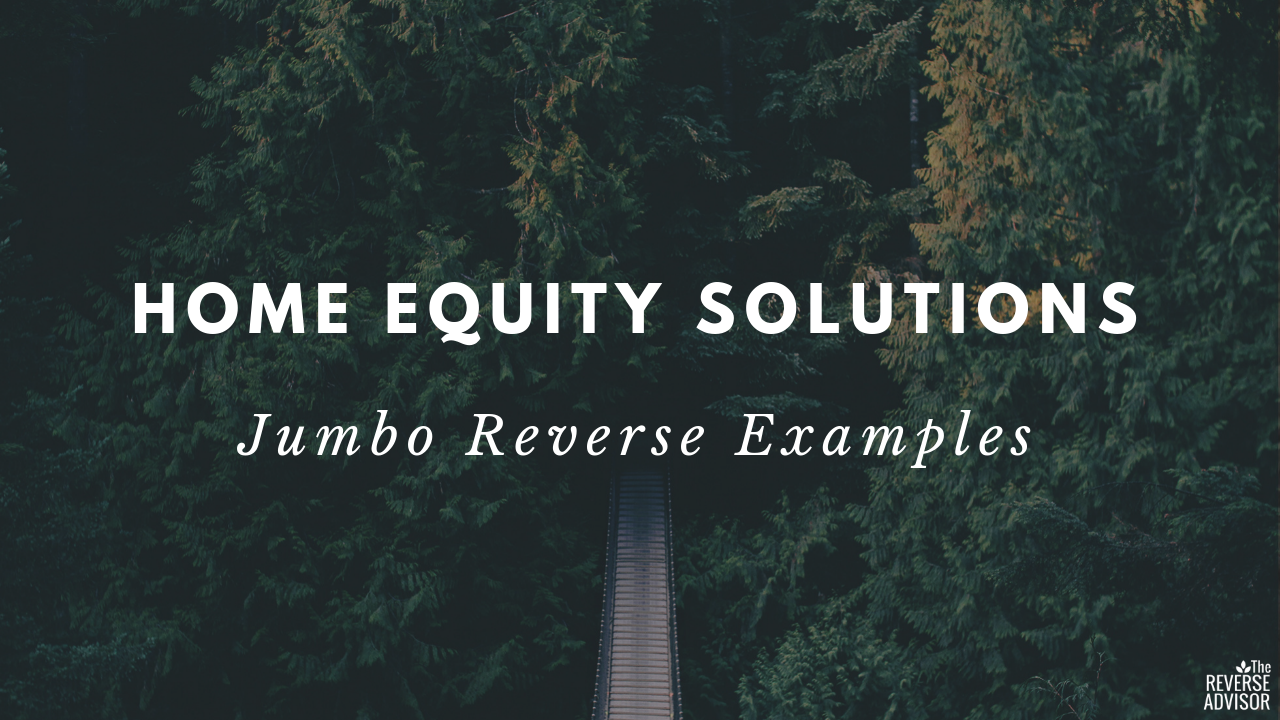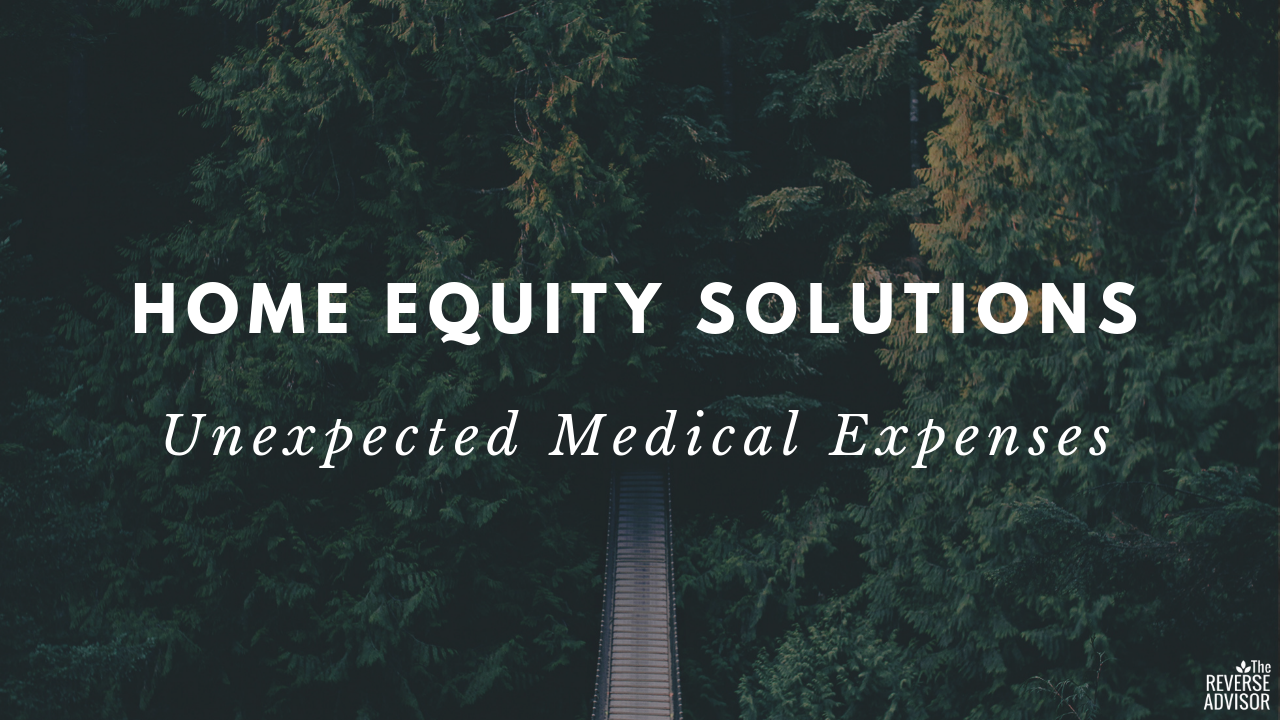5 New Jumbo Reverse Mortgage Options

Everything we do revolves around improving our clients' quality of life in retirement. Let’s face it, money stress can be all consuming – in a bad way.
And only from a position of strength can we help others. Finally, helping loved ones on this side of the finish line is more fun than the alternative.
Let’s talk about some good news. 2018 has been a year of significant innovations and improvements for jumbo reverse mortgages – the financial tool that helps higher net worth homeowners access some of the wealth that’s trapped in their house.
The purpose of this article is to (1) bring you up to date on the new jumbo reverse mortgage options, and (2) teach you the three most important questions to ask so you know you’re choosing the optimal solution. If you'd like to talk to us about your situation, click the Reverse Mortgage Qualifier button below and we will generate a report from our reverse mortgage calculator based on your unique situation.
In part one of this three-part series, we covered a brief history of jumbo reverse mortgages and explained how recent changes to the popular government-insured reverse mortgage program have made them even less useful to those with higher-value homes; i.e., houses worth over $1 million.
This article is about the exciting changes and new options high-value homeowners now have.
Let's start with a quick recap of the many benefits of jumbo reverse mortgages, compared to the popular FHA version.
Jumbo Reverse Mortgage Benefit Recap
- More money
- Lower closing costs (no mortgage insurance)
- Allowed to pay off debts to qualify
- Loan amounts to $4 million
- Can get all proceeds at closing – don’t have to wait one year
- House value not capped at FHA's national lending limit
- One appraisal on values up to $2 million
- Can have 4 financed properties plus primary residence
- Non-FHA approved condos
2018 Jumbo Reverse Mortgage Upgrades
Below we’ll unpack the details around the top five new jumbo reverse mortgage options or upgrades, which include:
- Higher loan amounts
- Deferred disbursement option on fixed rate loan
- Age requirement dropped to 60
- Reverse second mortgage
- Jumbo reverse with a line of credit
Any one of these innovations would have been noteworthy. Adding all five in a short period of time greatly amplifies the usefulness of home equity conversion mortgages to support wealth management planning.
The biggest challenge is getting the word out and helping higher-home-value homeowners and financial planners understand the practical ways of leveraging these new options. I’ll try to help you connect the dots with some charts and stories.
Jumbo Fixed Rate Options
The benefit of a jumbo fixed rate reverse mortgage is the safety and security of knowing what the interest rate will be. If you’re of the opinion that rates are going to increase, and that our collective deficit spending could mean rates rise considerably, a fixed rate provides peace of mind.
One of the biggest differences between the FHA and jumbo version is that with FHA, there are limits around how much can be accessed at closing (60%). Not only are FHA borrowers dealing with lower loan amounts, but having to wait a year to get up to 40% of what they’re eligible for is sometimes a big issue.
The jumbo reverse doesn’t have that constraint. The borrower can have the full loan amount at closing. However, before the recent innovations, a homeowner had to take the full amount.
What if they don't want all the money on day one?
What if they don’t want to pay interest on money they don’t need?
Introducing the deferred disbursement option, which allows a jumbo reverse borrower to spread out up to 40% of their proceeds over the first five years. Check out our recent client, Dr. Thompson, where we crafted a hybrid jumbo reverse mortgage strategy that may save him up to $228,00 by leveraging this delayed disbursement option.
Jumbo Second Mortgage
The jumbo reverse mortgage in second lien position is just what it sounds like: a second mortgage where the homeowner doesn’t have to make a monthly mortgage payment.
This is ideal for someone who has a low interest rate on their existing first mortgage, they can comfortably make the current payment, but they either (a) can’t qualify for a second mortgage, or (b) don’t want to make an additional mortgage payment on a HELOC (home equity line of credit).
People in this group have the luxury of being concerned with legacy, preserving estate value, but still need to access some of the wealth trapped in their home to do what they want.
Second mortgage examples that come to mind include:
- Gifts, like helping children with a down payment on a home
- Early inheritance strategies
- Home improvements
- Medical or insurance expenses
- Bridge financing for construction or business
- Settling taxes or judgments
- Buying a second home or timeshare
- Helping with children’s or grandchildren’s college expenses
- Travel, lifestyle, etc.
Many of our long-time clients have first mortgages with 30-yr fixed rates around 3.25%. It would be silly to pay that off if not necessary.
Jumbo Reverse Mortgage Line of Credit
This option is perhaps the most exciting. People, whether they’re 4 or 84, want two things: choice and control. While we’ve long been grateful for the standard fixed rate option, having to take all the money at closing is often less than ideal.
A large initial disbursement means trying to figure out what to do with money that’s not currently needed. One obvious solution is to invest the excess to try to offset the interest carrying cost. This is dangerous territory because the average person dramatically underperforms the market.
If you find yourself in a position with more money than you know what to do with, get a good financial advisor. We work with some of the best. If you ask, we’ll give you names.
Now, home owners can get a jumbo reverse mortgage, with a line of credit feature – similar to the FHA reverse mortgage – but with no mortgage insurance. This is a big deal. The jumbo reverse line of credit matches the initial draw with a 10-yr line of credit. At the end of ten years, the loan does not become due nor do amortizing payments have to be made.
Below you’ll see an example of how that provides some free lift to an already good solution.
Recent Improvement – More Money, Higher Loan Amounts
In April, 2018 I wrote an article and created a video that walked through the pros and cons of jumbo reverse mortgages. Then, in the summer of 2018, jumbo reverse loan amounts (principal limits) were increased.
One of the challenges of writing about loan programs is how quickly they change. Nonetheless, financial professionals, CPAs, and trust attorneys tell us having a rough idea is better than no idea.
Here are four charts that show how much can be accessed with a jumbo reverse mortgage based on age and house value. Keep in mind, these amounts can and will change based on rates and other factors.
$1 Million Value, Jumbo vs FHA

2019 National Lending Limit
$1 Million Value – Jumbo Reverse Options

$1.5 Million Value – Jumbo vs FHA

2019 National Lending Limit
$1.5 Million Value – Jumbo Reverse Options

Jumbo Benefit – No Mortgage Insurance
Closing costs on jumbo reverse mortgages are much less than FHA reverses, largely because there’s no upfront or annual mortgage insurance. To be fair, FHA mortgage insurance does provide certain benefits to borrowers, as well as lenders, but that’s a topic for another day.
In December, 2018, HUD raised the FHA HECM maximum claim amount to $726,525. Recall, the upfront mortgage insurance amount is based on the home value or National Lending Limit, not the loan amount. So an increase in this limit has the effect of a higher upfront mortgage insurance premium.
If someone takes out a small-draw FHA reverse mortgage loan (with a substantially unused line of credit), they still pay 2% upfront mortgage insurance on the value of the house. That equates to: 2% of $726,525 = $14,530
Not having to pay for mortgage insurance is why closing costs are much less with a jumbo reverse mortgage; i.e., $14,530 less.
And not having to pay annual mortgage insurance further lowers long-term costs. For example, the 10-year cost of annual mortgage insurance on a $340,000 FHA reverse would total $23,754. With a jumbo reverse, the annual mortgage insurance cost is zero... because there is no insurance.
Top 5 Uses of Jumbo Reverse Mortgages
As you might imagine, jumbo reverse mortgages are more about lifestyle than need. We often talk to clients who have a half million or more in retirement accounts but they prefer to protect that liquidity. They know that their house will appreciate at the same rate whether it has a mortgage on it or not.
Data on recent jumbo reverse mortgage loans revealed borrowers are older and have larger loan amounts than expected. The average borrower age was 77 with a home worth $1.7 million.
The top five reasons for getting a reverse mortgage, in order, are as follows:
- Home renovation, remodel, or repairs
- Purchase vacation home or rental property
- Help children buy a home
- Gifting to heirs - early inheritance
- Help adult children's kids (grandkids) with college
How to Compare and Select the Best Reverse Mortgage
Dan Sullivan, founder of Strategic Coach, says…
“Answers are a dime a dozen. What’s rare in this world is a really great question.”
After more than ten years in the reverse mortgage space, we believe homeowners and their advisors should each ask three questions.
Borrowers
- How much can I get?
- How long will it last?
- At the end, how much wealth is left?
Financial planners
Based on a given time frame or planning horizon:
- What is the cumulative cost of borrowing (closing costs, interest, insurance, servicing)?
- How will a home equity solution affect other asset accounts?
- How does credit line growth increase borrowing power?
As a Certified Reverse Mortgage Professional™, I also like to get input from my clients' financial advisors on the following four variables, on a year-by-year basis:
- Expected future rate of house price appreciation - they usually look to me for this
- Timing and amount of cash taken out or put in - they usually consult with the borrower for this
- Offset investment account rates of return
- Interest rates
I have my opinion on these variables but clients are best served when everyone who is giving them financial advice is aligned on key assumptions. It takes more work to get a consensus, but it really helps prevent competing priorities from undermining a client’s well-being.
It’s critical to discuss these variables (rates, appreciation, etc.) because assuming homes will appreciate at 4% every year, or interest rates will always stay the same, is not realistic. There’s a difference between taking risks versus measuring risk and taking action.
Too often, we see excess risk taking by clients with illiquid (can’t easily be converted to cash) investments. If they have to sell at the wrong time, instead of making the 10-20% return shown in the brochure, they end up losing half their money. Seniors can’t afford these mistakes because they don’t have time to recover.
It’s almost always the same story, because someone hasn’t saved enough, they feel like they ‘have to take risks’ to make up for lost time. If they took a holistic look at their wealth, including wealth trapped in their home – home equity - they'd usually make different, better decisions.
Our role is to help people overcome the distress of too little cash or monthly income, without taking foolish risks.
We find clients relate to stories and pictures more than a discussion on features and benefits. Be sure to check out our Jumbo Reverse Mortgage Examples article, which is part three of this series and is based on real-world stories from client conversations; click here.
Our expertise, as a home equity solution specialist, gives our clients a sense of direction, which increases their confidence and helps them and their advisors feel comfortable they’re making optimal decisions.
Do you or someone you know need guidance? Click the Free Reverse Mortgage Qualifier button below for help understanding options and for us to calculate, in dollars, the short- and long-term benefit of one choice versus another.
Resources | References:
- Hybrid Jumbo Reverse Mortgage Strategy, Kent Kopen, 11/14/18, The Reverse Advisor - https://www.thereverseadvisor.com/blog/hybrid-jumbo-reverse-mortgage-strategy
- Americans are still terrible at investing, annual study once again shows, Lance Roberts, Market Watch - https://www.marketwatch.com/story/americans-are-still-terrible-at-investing-annual-study-once-again-shows-2017-10-19
- Jumbo Reverse Mortgage – Pros & Cons, Kent Kopen, 4/10/18, The Reverse Advisor - https://www.thereverseadvisor.com/blog/jumbo-reverse-mortgage-pros-and-cons
- Jumbo Reverse Mortgage, Kent Kopen, 4/25/18, YouTube - https://youtu.be/B2HrzdICGKU
- 2019 Nationwide Home Equity Conversion Mortgage (HECM) Limits, 12/14/18, FHA Mortgagee Letter 2018-12 - https://www.hud.gov/sites/dfiles/OCHCO/documents/18-12hsgml.pdf
- Jumbo Reverse Mortgage Examples, Kent Kopen, 12/10/18, The Reverse Advisor – https://www.thereverseadvisor.com/blog/jumbo-reverse-mortgage-examples
- FHA HECM; margin 2%, expected rate 4.9%.
* Always review important financial decisions with your own legal and tax professionals.
About the Author
 Kent Kopen earned his Reverse Mortgage Specialist credential in March 2007. Last year Kent earned the CRMP (Certified Reverse Mortgage Professional) designation. There are less than 170 CRMP designees in the United States. Mr. Kopen also provides education, tools, and strategies to professionals who offer financial and legal advice to others. "Our resources help financial advisors, CPAs, and estate planning attorneys help seniors optimize their home equity to provide greater security and peace of mind."
Kent Kopen earned his Reverse Mortgage Specialist credential in March 2007. Last year Kent earned the CRMP (Certified Reverse Mortgage Professional) designation. There are less than 170 CRMP designees in the United States. Mr. Kopen also provides education, tools, and strategies to professionals who offer financial and legal advice to others. "Our resources help financial advisors, CPAs, and estate planning attorneys help seniors optimize their home equity to provide greater security and peace of mind."



